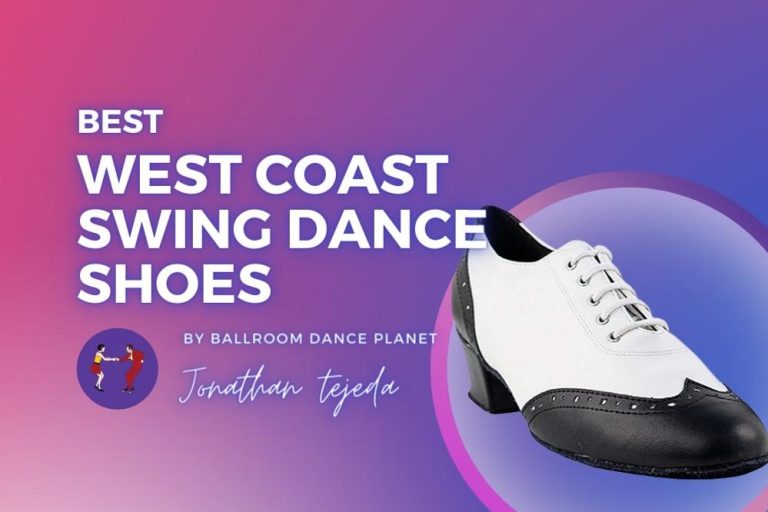Here are the 12 Types of Ballroom Dances and Their Fascinating Definitions

Are you curious about the different types of ballroom dances? There are many of them, and each has its unique characteristics.
In this article, we’ll look at some of the most popular ballroom dances. Stay tuned – we’ll cover each one in detail in future posts!
Types of Ballroom Dances: Overview
Ballroom dancing is an umbrella term for various partner social dances.
The dances differ in techniques, costumes, and rhythm, but they all have common elements such as control and cohesiveness, elegance, and flow.
The different styles make it a dance for people of all dance levels, including beginners.
Because of the rise of dance sports today, the scope of ballroom dance has become narrow and now denotes the internationally recognized two styles:
- The standard ballroom dance
- Latin ballroom dance
Standard Ballroom Dance Styles

The World Dance Council and the World DanceSport Federation regulate the types of ballroom dances.
Below are the ones characterized as standard styles of ballroom dancing.
1. Waltz
Waltz was first danced as a country-folk dance in Bavaria and Austria in the 17th century and later introduced in England in the 19th century.
It is the smoothest type of ballroom dance, consisting of uninterrupted turns, rise and fall, and long, flowing moves.
It involves postures where the man holds the woman close to his body.
While dancing, the upper body is maintained to the left side throughout all stances.
On moves where the woman leaves the man, she must be on his right side while her head extends to follow the elbow.
The movements in the waltz involve rotations with a slight rise and sways on the second step.
2. Tango
Tango came from Buenos Aires in the late 19th century.
It involves movements where the women dance harmoniously with the tango male leader.
The dance is like walking to music, but you keep your feet grounded.
On every step, your knees and ankles brush against each other.
3. Foxtrot
Foxtrot is an American ballroom dance first performed by Harry Fox in 1914.
It is easy to learn, making it the ideal ballroom dance for beginners.
It involves long, smooth, and flowing movements through the dance floor.
4. Quickstep
The quickstep is an English dance developed in the 1920s.
Fast movements, including runs, characterize it, walks, chases, and some combinations of the Charleston and quicker foxtrot tempo.
Latin Ballroom Dance Styles

The Latin styles of ballroom dancing usually have more complicated steps and forms, which are suitable for advanced ballroom dancers.
1. Pasodoble
Originating from Spain, pasodoble is basically a dance that portrays bullfights.
It has many choreographic instructions, so it is popularly performed in competitive ballroom dances.
2. Cuban Bolero
Fashioned from the form of trova and using the traditional song in eastern Cuba, the Cuban bolero is the most loved ballroom dance in Latin America.
It is a dramatic dance of couples falling in love with which the movements involve a combination of other ballroom dances, including slow salsa, rhumba, waltz, and foxtrot.
3. Spanish Bolero
The Spanish bolero was formed out of seguidilla in the late 18th century and was popularized by famous court dancers like Sabastian Cerezo.
It was widely performed in the 19th century but became outdated in the 20th century.
It was replaced by Cuban bolero, another bolero style danced along with a Cuban music genre.
4. Samba
As the national dance of Brazil, samba is widely enjoyed by Brazilians of all ages.
It can be danced socially with a partner or solo during the Carnival in Rio de Janeiro.
It is also performed in many parts of the world, such as Paris, the U.S., and Latin America.
5. Rumba
Rhumba involves movements such as figure-eight hip rotation, revolving foot action, knee-lengthening, and other Cuban bolero dances.
It originated in Cuba and arrived in the U.S. in the 1920s.
Among the ballroom dances, Rhumba is the most sensual and romantic.
6. Mambo
Mambo is also a Cuban dance.
In fact, it is the spin-off of danzon, the national dance of Cuba.
It was developed by brothers Orestes and Cachao Lopez in the 1930s.
It became very popular in the 1940s and 1950s in Cuba and New York.
Mambo is considered the most emotional ballroom dance.
It involves arm movements, facial expressions, and hip movements that make up the overall sensuality of the dance.
7. Cha-cha

Cha-cha involves flirtatious movements with many hip rotations and synchronized partner movements.
It is also performed by curving and straightening the knees.
Enrique Jorrin developed cha-cha in the 1950s as a sluggish version of Mambo.
Box Step, The Foundation of Ballroom Dance
The foundation of all ballroom dances is the box step.
You can practice this movement before you enroll yourself in a ballroom dancing class so you would get the feel of it all.
In performing a box step, you basically move your feet in a square.
You start with your feet together while putting your weight on the right foot.
Then, move your left foot forward in only a small step while you transfer your weight on this foot.
Forward your right foot through the side of your left foot, ensuring a small space between your feet.
Finally, shift your weight on your right foot and join your feet together by moving your left foot beside your right foot.
Do the second sequence, only backward.
Always remember to move the outside leg, instead of the inside leg, around the square.
Frequently Ask Questions (FAQ)
What are the 12 ballroom dance style?
The 12 ballroom dance styles are:
1. Waltz: A graceful, smooth dance characterized by sweeping, gliding movements.
2. Tango: An expressive and passionate dance with staccato movements and intense partner connection.
3. Foxtrot: A smooth, elegant dance featuring long flowing movements and an easygoing style.
4. Viennese Waltz: A faster version of the Waltz, known for its continuous rotation and exhilarating pace.
5. Quickstep: A lively dance with brisk movements and syncopated steps, combining elements of Foxtrot and Charleston.
6. Cha-Cha: A vibrant Latin dance with playful hip actions and quick footwork.
7. Rumba: A slow, sensual Latin dance focusing on expressive body movements and connection.
8. Samba: An energetic and lively Brazilian dance with rhythmic hip movements and vibrant music.
9. Paso Doble: A dramatic dance inspired by Spanish bullfighting, characterized by strong, powerful movements.
10. Jive: A fast paced and energetic swing dance with lively kicks and flicks.
11. East Coast Swing: A classic swing dance with a fun, bouncy feel and triple-step patterns.
12. West Coast Swing: A more modern swing variation with a smoother style emphasizing partner connection.
These diverse styles offer various music and movements, making ballroom dancing a dynamic and captivating art form.
What is the most intimate ballroom dance?
The most intimate ballroom dance is often considered to be the Argentine Tango. With its origins in the streets of Buenos Aires, Argentina, the dance is characterized by intense and passionate partner connection.
Argentine Tango involves close body contact, intricate leg and footwork, and a strong focus on improvisation and communication between the partners.
The dance fosters a deep connection, trust, and emotion, making it a truly intimate and expressive ballroom dance style. Dancers explore a profound connection as they interpret the music and share a unique and personal dance experience.








I used to do a lot of street latin dancing and I absolutely loved it. And even though I don’t go to formal classes anymore, I love the fact that I can still go out for a social dance and know what I am doing. Learning how to partner dance is a really great social skill to have and it can really make for a great night out as well as for an excellent form of exercise when it comes to the more vigorous types of dancing. I thought you laid out all the styles of ballroom very nicely here.
Thank you Liz for sharing!… We are happy to hear that you got value from our post! :D
I never thought I would ever be decent at any kind of dancing that wasn’t free-style. Twenty or, so years ago I decided there was nothing to lose by trying Ballroom Dance! I’m glad I did. I’m had to stop in and agree with the author wholeheartedly, don’t say “no” to dancing if you don’t have to! Even my friends in wheelchairs love to dance and, we get creative!
When I moved out West I feel in love with Latin ballroom & Latin dances in general. My good girlfriend even taught me and wowed me that she could be in either partner position.
Thank you for the historical breakdown as well Abraham. Dance is movement medicine!
Hey Fyre!… I’m so happy to hear that you didn’t give up on yourself and started your dance journey… Dancing can be a little intimidating when you first get started… But once you start theres no going back, “burn the dance floor” :)
Thank you for sharing your story!